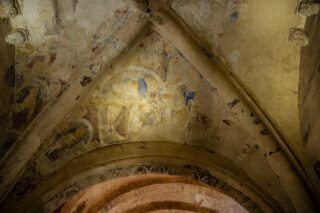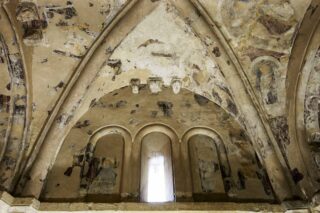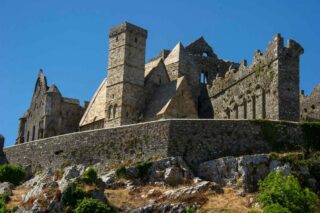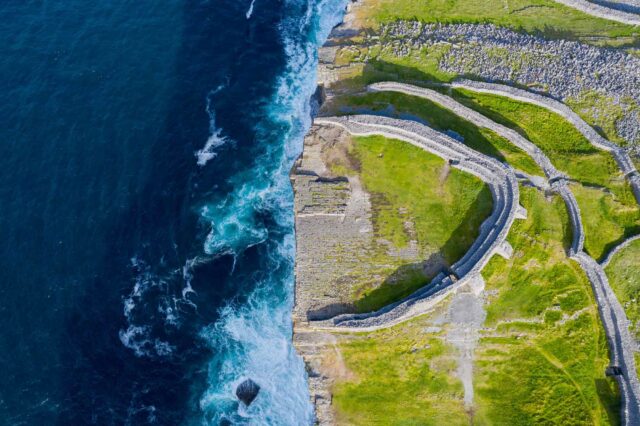
Royal Paintings
The wall paintings in the chancel of Cormac’s Chapel form the earliest known decoration of its kind in Ireland and date from the mid-12th century. The Paintings record scenes from the early Life of Christ.
Although much has been lost, the fragmentary wall paintings are the remains of one of the most important and sophisticated schemes of mural painting in the country. Painted in expensive and sophisticated pigments, employing techniques found throughout royal courts and high status churches and cathedrals in early medieval Europe, the paintings are one of a rare and dwindling number of examples which give an insight into the rich and colourful world of royal art in 12th-century Ireland.
The conservation work on these paintings was begun by the Perry Lithgow Partnership[i] in 1986, and completed in 1997, and consisted of the painstaking removal with scalpels of the numerous layers of extremely hard-covering limewash which had calcified on to the surface. Loose plaster was reattached and extensive replastering using similar lime plaster was carried out.
However, following conservation, the sophisticated and complex original materials and techniques continued to be particularly vulnerable to the harsh environment in the exposed chapel, sitting high on the limestone bedrock outcrop at Cashel. In fact, the environmental conditions which posed a risk to the paintings continued to be a risk for the more durable stonework as they were slowly but irrevocably eroding surfaces and removing the rich and ornate detail.
Over the long term, environmental factors are just as likely to cause painting and sculpture to deteriorate with vital details fading or crumbling until they are entirely lost. Painted surfaces are particularly vulnerable, not only because of the delicate materials in which they are painted but also because the visible surface is so thin. For example, if 1mm of the surface is lost from an area of carving, there might be a mild change in appearance. If 1mm erodes from the surface of a wall painting, that painting will be entirely lost.

The paintings are also more vulnerable than many other elements of the building as they are a laminate structure formed of a number of layers of differing materials, all of which can powder and flake in response to different environmental factors.
Environment deterioration refers to the collection of conditions in the air and ground to which the physical structure of the building (including the paintings) is exposed and with which it will interact. The most significant parameters in the case of Cormac’s Chapel are heat, moisture and light.
On the exterior, rainfall (liquid water) strikes the surface of the building. Some will run off to the ground and some will penetrate the walls where it dissolves the salts and other materials with which the building is contaminated. When the wind strikes the exterior and the rain dries on the surface, the salts will crystallise causing the surface of the stone to crumble. Where the water penetrates to the inside, it will allow algae and other micro-organisms to grow. These are not only visually intrusive but the physical structures by which they attached themselves to the stone and plaster dig into the surface causing deterioration. Furthermore, many of the micro-organisms give off corrosive materials, such as oxalic acid, as part of their lifecycle, which causes the material to which they are attached, particularly the chemically sensitive material such as paint layers, to deteriorate.
Evaporation of the water from the internal surfaces increases the humidity within the building which encourages microbiological attack to wider areas and also causes condensation on cold surfaces. The unstable moisture conditions then cause salt crystallisation and dissolution, as seen on the outside, causing damage to internal stonework and painting. Damage of this type is slow, chronic and irreversible.

Control and Conservation
The only way to control environmental deterioration of this kind is to ensure that the building is successful in removing rainwater from the structure and that the microclimate within the building can be effectively controlled.
In 2002, a programme of research was initiated to establish the areas in which the building structure was failing and to characterise the internal microclimate sufficiently accurately in order to allow it to be controlled. This involved a careful study of the building and the wall paintings themselves, including analysis of the plaster and painting materials and a detailed study of the environmental conditions using long-term environmental monitoring.
Tobit Curteis Associates[ii] commenced a project to monitor and gather data on humidity and temperature throughout the day and night in order to understand the effect of water penetration variations in temperature and air exchange between the internal and external spaces.
A roofed and enclosing scaffold was completed in 2010. Crucially, this allowed the building structure to begin to dry out as well as providing an access scaffold for repair work. This was a highly complex operation not only for structural reasons but also because of the very large volumes of rainwater that needed to be removed from the over-sailing roof of the scaffold. The scaffolding also provided a secure and safe working platform for the OPW workforce carrying out conservation and repairs to the masonry fabric under the direction of Foreman Liam Mulhall.
The results of this work formed the basis of the design for the repairs to the masonry structure and the installation of rainwater goods to ensure that the building envelope functions correctly. The resulting reduction in the volume of water within the structure lowered the level of internal evaporation and began to bring the conditions within the building under control. However, this alone was insufficient to improve the conditions to the required level and a system was designed to sample internal and external air and, when the external conditions were positive, to allow fans to operate thereby ventilating the internal space with drier air from the outside.
Alongside the environmental controls, a programme of treatment of the biodeterioration was carried out using ultraviolet radiation of the type employed in water purification in order to reduce the level of microbiological growth on the internal architectural surfaces, including carvings and paintings. Conservation treatment of the paintings has also taken place throughout this period, with the condition of the paintings having been carefully evaluated at regular intervals.
In combination with the repairs to the masonry structure, the active environmental control has been successful in reducing and stabilising moisture levels, thereby reducing the level of damage and salt activity. The treatment of the microbiological growth has also been effective and the control of the environmental conditions has limited the extent to which it can easily re-establish itself causing further damage.
Conservation of this type is not a one-off operation and physical and environmental conditions will continue to be monitored in order to ensure that the architectural surfaces and paintings remain in good condition. However, the work that has been undertaken over the last fifteen years has ensured that these unique and important paintings are now in better condition and are better protected than has been the case throughout their recent history. Employing both traditional and innovative methods as part of the conservation of the building and wall paintings, the project at Cormac’s Chapel can be considered to be one of the most advanced of its kind.

About the Author
Michèle O’Dea is a Senior Conservation Architect with the Office of Public Works. Michèle has worked in the Heritage Services, National Monuments division since 2000. She is currently responsible for the care and presentation of National Monuments in the west and north-west of Ireland.
[i] Established in 1983 the Perry Lithgow Partnership operates throughout the UK and Ireland specialising in wall paintings, panel paintings and paintings on canvas and stone. The Partnership acts as Wall Painting Conservation Advisers to the National Trust.
[ii] Tobit Curteis Associates is a practice specialising in the investigation, monitoring and control of environmental deterioration in historic buildings and collections and the conservation of wall paintings and polychrome surfaces.

